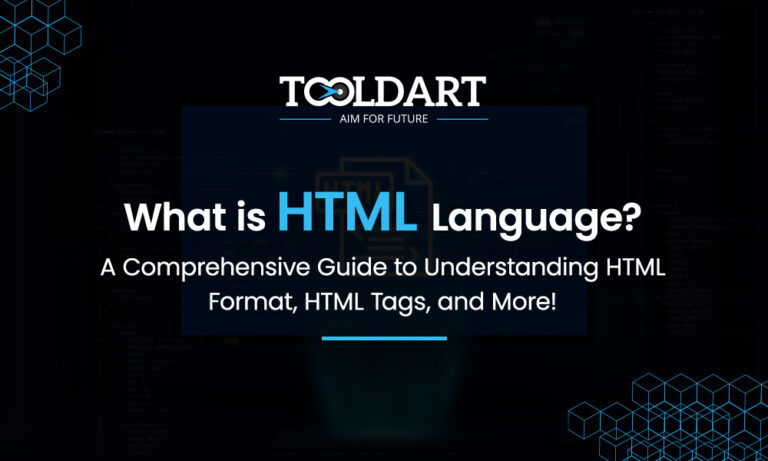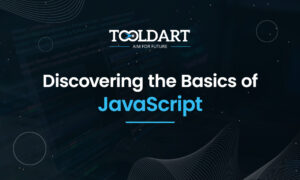What is HTML Language? A Comprehensive Guide to Learn in 10 Minutes!

HTML is a fundamental technology that is used to create websites and web applications. It stands for HyperText Markup Language and is the standard markup language for the World Wide Web. In this comprehensive guide, we’ll discuss everything about HTML language, including the HTML format, HTML tags, and much more.

What is HTML Language?
HTML is a markup language that is used to structure and display web content. It provides a framework for creating web pages that include text, images, videos, and other types of multimedia content. The HTML language is designed to be readable by both humans and computers, making it a crucial tool for web developers and designers.
HTML was created in the late 1980s by Tim Berners-Lee and has evolved over the years to become the standard markup language for the World Wide Web. It is an open standard, which means that anyone can use it to create websites and web applications.
HTML Format
The HTML format is used to define the structure and content of web pages. Coding HTML documents consists of a series of elements that are surrounded by tags. These tags are used to specify the type of content that is being included in the document, such as headings, paragraphs, lists, links, and images.
(You can learn from HTML tutorial for beginners)
The HTML format uses a series of opening and closing tags to define elements on a web page. For example, the following code creates a heading element:
<h1>This is a heading</h1>
The opening tag, <h1>, specifies the start of a heading element, and the closing tag, </h1>, specifies the end of the element.
HTML tags can be grouped into several categories, including:
- Structural tags, which define the structure of a web page, such as headings, paragraphs, and lists.
- Semantic tags, which define the meaning of the content, such as headings, links, and images.
- Deprecated tags, which were used in earlier versions of HTML but are no longer supported.
HTML Attributes
In addition to HTML tags, HTML also uses attributes to provide additional information about elements on a web page. Attributes are used to specify the properties of an element, such as its size, color, or style.
For example, the following code creates a link element with the attribute href, which specifies the URL of the page being linked to:
<a href=”https://www.example.com”>This is a link</a>
Understanding the Basics of HTML
To get started with HTML, it’s important to understand the language basics, including the syntax and structure of HTML documents that might be available on html tutorial for beginners.
HTML documents start with a document type declaration, which defines the HTML version being used. The following is an example of a document-type declaration:
<!DOCTYPE html>HTML documents also include a head section, which provides information about the document, such as the title, description, and keywords for search engines. The following is an example of a head section:
<head>
<title>This is the title of the web page</title>
<meta name="description" content="This is a description of the web page">
<meta name="keywords" content="HTML, web design, web development">
</head>The body section of an HTML document contains the main content of the web page. This is where you can include text, images, videos, and other types of multimedia content.
How Many coding HTML Tags Are There?
There are over 100 HTML tags that can be used to create web pages. These tags can be grouped into several categories, including structural tags, semantic tags, and deprecated tags.
Some of the most commonly used HTML tags include:
- <html>: Defines the start and end of an HTML document.
- <head>: Defines the head section of an HTML document.
- <title>: Defines the title of the web page.
- <body>: Defines the body section of an HTML document.
- <h1> to <h6>: Define headings of different levels.
- <p>: Defines a paragraph.
- <a>: Defines a hyperlink.
- <img>: Defines an image.
- <ul>: Defines an unordered list.
- <ol>: Defines an ordered list.
- <li>: Defines a list item.
HTML and CSS
HTML and CSS are two of the most important technologies used to create websites and web applications. HTML provides the structure and content of web pages, while CSS provides the styling and layout.
CSS can be used to change the look and feel of a web page, including the colors, fonts, and spacing. It can also be used to create complex layouts and animations.
When used together, HTML and CSS provide a powerful, flexible solution for creating dynamic and engaging web pages.
HTML and JavaScript
HTML and JavaScript are also frequently used together to create interactive web pages. JavaScript is a programming language that is used to add interactivity to web pages, such as drop-down menus, pop-up windows, and dynamic content.
JavaScript can be used to manipulate the HTML document, update the content dynamically, and respond to user interactions. When used in conjunction with HTML and CSS, JavaScript provides a powerful solution for creating dynamic and interactive web pages.
HTML Versions
HTML has undergone several major updates since its creation in the 1990s. Each new version of HTML has introduced new features and capabilities while also retiring older features that are no longer necessary.
The most recent version of HTML is HTML5, which was released in 2014. HTML5 introduced a number of new tags and features, such as semantic elements, multimedia support, and improved accessibility.
HTML Validation
HTML validation is checking an HTML document to ensure it conforms to the HTML standards and specifications. Validating your HTML code is an essential step in the web development process, as it can help identify errors and ensure that your web pages are compatible with a wide range of browsers and devices.
HTML and Mobile Devices
With the growing popularity of mobile devices, it’s more important than ever to create websites that are optimized for small screens and touch-based interactions. HTML provides several features and capabilities for creating responsive websites that can adapt to the size of the screen and provide an optimal viewing experience for users.
HTML Tools and Resources
There are a variety of tools and resources available for learning HTML and creating web pages. Some popular tools include text editors like Notepad++ or Sublime Text and integrated development environments (IDEs) like Visual Studio Code or Brackets.
Online resources such as tutorials, forums, and documentation can also be a great way to learn HTML and stay up-to-date with the latest trends and best practices.
HTML and Web Accessibility
Web accessibility refers to the practice of making web pages and digital content accessible to people with disabilities. HTML provides several features and capabilities for creating accessible websites, such as semantic elements, alternative text for images, and proper use of headings and landmarks.
By following best practices for web accessibility, HTML developers can ensure that their web pages are accessible to a wide range of users, including those with visual, auditory, and motor disabilities.
HTML and the Future of the Web
HTML is an essential technology that will continue to play a critical role in the future of the web. As technology evolves and new devices and platforms emerge, HTML will continue to evolve and provide new features and capabilities for creating dynamic and engaging web pages.
To stay ahead of the curve and take advantage of the latest developments in coding HTML, and web development, be sure to stay connected with the Tooldart community and explore the many resources and tools available at our site.
Conclusion
HTML is a fundamental technology that is used to create websites and web applications. It provides a framework for creating web pages that include text, images, videos, and other types of multimedia content.
With over 100 HTML tags and a flexible syntax, HTML is a versatile and powerful tool for web developers and designers. When used in conjunction with CSS and JavaScript, HTML provides a complete solution for creating dynamic and engaging web pages.
If you’re interested in learning more about HTML language, check out the resources and tools available at Tooldart. Our team of experts is dedicated to helping you improve your web development skills and stay up-to-date with the latest trends in the industry.
HTML tutorial for beginners
There is always a chance to learn and strengthen your HTML language with html tutorial for beginners. To learn more, connect with TOOLDART today!




